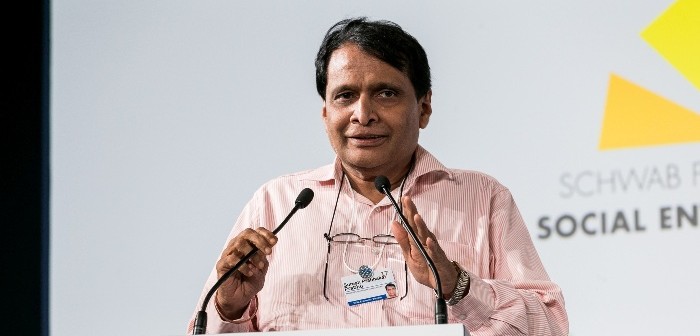A recent raft of measures revising India’s foreign trade policy is set to bolster exports and further the ease of doing business in the country, writes India Inc. Founder & CEO Manoj Ladwa.
The Narendra Modi government this week gave a big boost to flagging Indian exports by announcing several measures to revive foreign trade and ease disruptions caused by the implementation of the landmark Goods and Services Tax (GST).
To overcome the issue of stagnating export growth, India’s Commerce Minister, Suresh Prabhu, widely rated as one of the country’s most dynamic ministers, announced a slew of measures to incentivise exports from the nation’s labour intensive micro, small and medium (MSME) sector.
I won’t list the entire range of measures rolled out this week. I’ll focus only on a few that I feel can make an immediate difference.
The government has raised incentives under the Merchandise Exports from India Scheme (MEIS) by 2 per cent to exports from labour and MSME dominated sectors such as gems and jewellery, leather and leather products, carpets and agriculture. It had earlier done the same for ready-made garment exports.
The services sector, which makes up 60 per cent of the Indian economy and accounts for a large volume of exports, has also been given a similar 2 per cent increase in incentives.
The ministry also launched a new initiative to use trade analytics to identity new markets for its products and new products for existing markets.
The goal is multi-fold: increase exports, provide a boost to employment generation in sectors such as leather and leather products, garments, gems and jewellery, handicrafts and agriculture that are highly labour intensive and kick-start GDP growth with a ground-up approach.
Allow me to break off at this point to provide some context for this piece. India’s Foreign Trade Policy (FTP) had proposed a hefty rise in the country’s merchandise and services exports to $900 billion by 2019-20. But sluggish global conditions, a bad loan crisis plaguing domestic banks and, over the last few months, teething troubles faced by GST, the most ambitious and largest tax reform every attempted in India (and probably the world), have combined to slow down export growth.
Minister Prabhu unveiled several measures to improve the ease of doing business for exporters by cutting red tape and automating more processes.
“Exports are a strategic part of our economic policy,” Indian Commerce Minister Suresh Prabhu announced at the mid-term review of the 2015-2020 FTP, while assuring the export sector that the government was serious about reviving the country’s exports, which had declined 1.1 per cent in October, amid concerns that exporters are declining to book fresh orders because of problems they are facing in complying with new GST rules.
The new incentives announced for boosting exports from labour intensive and services sectors under the revised FTP will cost the government an additional $1.3 billion.
Reading the fine print of the revised policy shows that the Modi government is simultaneously pursuing a short-term as well as a longer term strategy to ramp up exports. While the incentives are expected to provide an immediate palliative to exporters, it is addressing longer term structural issues faced by exporters by creating an enabling eco-system to shore up their competitiveness and productivity by streamlining the supply chain, ironing out the glitches in the implantation of the GST, and also by improving the ease of doing business within the country.
It will do so by setting up a single point of contact at the Directorate General of Foreign Trade for exporters and importers.
“The review aims to promote exports by simplifying processes, boosting support to high-employment sectors and leveraging benefits of GST, apart from helping double farmers’ income,” Minister Prabhu said and assured exporters that “we will constantly review the policy. We do not need to wait two-three years to make changes.”
![]() A common complaint of the exporters I have spoken with relates to the massive liquidity crunch they are facing due to delayed refunds under the new GST regime. This has largely been addressed by the review, though I suspect, many more modifications will be necessary over the next few quarters before all – or even most – of the most troublesome glitches are sorted out to the satisfaction of majority of exporters.
A common complaint of the exporters I have spoken with relates to the massive liquidity crunch they are facing due to delayed refunds under the new GST regime. This has largely been addressed by the review, though I suspect, many more modifications will be necessary over the next few quarters before all – or even most – of the most troublesome glitches are sorted out to the satisfaction of majority of exporters.
The government, for its part, has been addressing these issues on an ongoing basis. In October, the GST Council, the supreme decision-making body on GST, had re-introduced Advance Authorisation/Export Promotion Capital Goods/100 per cent Export-Oriented Units Schemes, which pre-date the introduction of GST, to enable exporters to source inputs from local and foreign suppliers without any payment of taxes. This was done to alleviate some of the liquidity problems faced by exporters. The government has also proposed an e-wallet to address the cash crunch faced by exporters.
As the minister, as well as Indian Finance Secretary Hasmukh Adhia, have promised, these are only the first of many more measures that the government will take in response to the problems being faced by the export sector.
As I sign off, I leave you with a few highlights of the revised FTP below:
- Annual incentives increased by 34 per cent to $1.3 billion
- Scope of Merchandise Exports from India Scheme (MEIS) and Service Exports from India Scheme (SEIS) raised for ready-made garments by 2 per cent
- Increase of 2 per cent in existing MEIS for exports by MSMEs/labour incentive industries
- Service sector incentives raised by 2 per cent
- Validity of Duty Credit Scrips increased from 18 months to 24 months
- Improved ease of trading across borders for exporters and importers
- New Logistics Division to promote integrated development of the logistics sector
- State-of-the-art trade analytics division in DGFT for data-based policy initiatives
- New agricultural exports policy to focus on increasing exports of value-added farm products
- New Services Division in DGFT to examine Exim policies and procedures to push services exports
- Supplies of goods and services to SEZs to be treated as zero rated under GST
- Import of second hand goods for repair/refurbishing/re- conditioning/re-engineering made free
- Steps to increase integration of Indian industry into global value chains
I am fairly confident that as other steps – such as the measures being taken separately to improve India’s raking on the World Bank’s Ease of Doing Business ranking as well as the bank recapitalisation programme to permanently resolve the bad loan crisis in the Indian banking sector gather momentum – the speed of integrating Indian businesses into the global supply chain will hasten.
And that’s when Indian exports will get a free run to fulfil their full potential.







